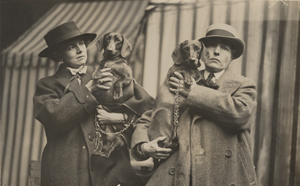
Dr. Jana Funke, Associate Research Fellow at the University of Exeter, U.K., visited the Ransom Center on a Hobby Family Foundation Fellowship in July and August 2010 to work on Radclyffe Hall’s short fiction. She is using the material she gathered for a monograph exploring the relationship between modernist sexualities and time. She is also preparing a critical edition of Hall’s unpublished works.
Radclyffe Hall is best known for her infamous novel The Well of Loneliness (1928), with its bleak depiction of female sexual inversion—a sexological term that combines traits we might nowadays classify as lesbian and transgender. It might therefore come as a surprise that spending several weeks in the archive working on Hall was tremendous fun! The Radclyffe Hall and Una Vincenzo, Lady Troubridge papers at the Ransom Center offer many delightful surprises, such as a box filled with kennel club information, show clippings, and photographs of Hall’s prize-winning dogs. While going through the drafts of The Well, I also came across a notebook in which she lists the “contents of an invert’s pocket.” Apparently, the female invert would not leave the house without a letter from her present love, three snapshots of her last love, a powder box, and lipstick.
While my visit gave me the opportunity to survey the archival material more generally, I spent most of my time working on Hall’s short fiction. Hall only published one collection of short stories, Miss Ogilvy Finds Herself (1934), but among her papers are more than 15 additional, mostly complete, unpublished stories, which were written in the 1910s and 1920s.
One group of unpublished works—including the unfinished novel The World—deal with the Great War. Whereas published texts like The Well or Miss Ogilvy Finds Herself focus on women’s experience of the war, the unpublished stories explore how men who were “unfit” to serve their country coped with the resulting sense of exclusion.
Other short stories deal with female experience; “The Modern Miss Thompson,” for instance, depicts the struggle for female autonomy and shows interesting parallels to Hall’s New Woman novel The Unlit Lamp (1924). Yet another set of stories provides insight into Hall’s engagement with religion, spirituality, and the supernatural. These texts deal with a range of subjects including the life of the medieval Saint Ethelflaeda, time travel, and mystic human-animal relationships.
The reasons why Hall did not publish more of these short stories are unclear. Hall’s notebooks reveal that she thought about publishing a larger number of short stories and sent a selection to her agent in 1924. We do not know why this publication did not materialize at the time. In her memoirs, Hall’s partner, Una Troubridge, suggests that by the time Hall was preparing the collection Miss Ogilvy Finds Herself in the early 1930s, she decided against including an earlier short story since it had “missed the boat.” It is possible that Hall felt her other short stories had also gone out of fashion by the time she was given the opportunity to publish them.
Returning to these texts almost a century after they were written, I found them anything but untimely. To be sure, the short stories confirm a certain image of Hall as an author with deeply conservative and often troubling national, racial, sexual, and class politics. However, my archival work also allowed me to develop a more nuanced understanding of Hall. Her unpublished work shows a writer keen to explore vastly different interests and stylistic approaches, and her investigation of questions of difference, outsiderism, and the struggle of belonging relates to scholarly concerns today. My time in the archive certainly did not present me with a radically new image of Hall, but it did allow me to explore a body of texts that is much more conflicted and less orthodox than I expected. I am very grateful to the Ransom Center, with its wonderful staff and sense of scholarly community, and the Hobby Family Foundation, for giving me this opportunity.
